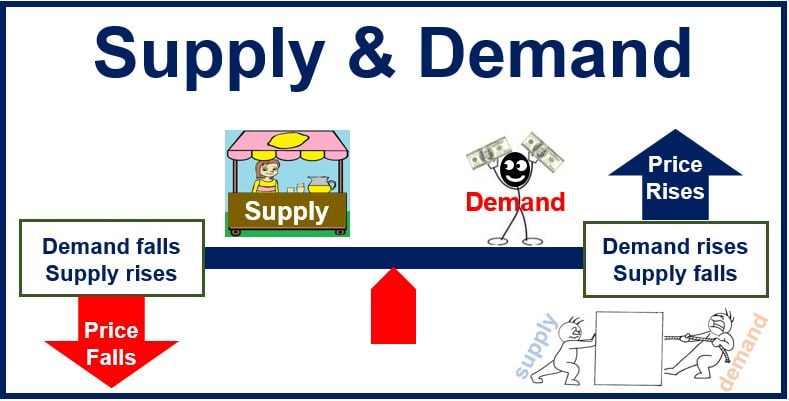In economics, the principles of supply and demand are paramount. They drive the prices of goods and services in a market economy, as well as salary levels. Their interplay helps determine the equilibrium price and quantity in various markets.
– Demand represents how much of a product or service people want.
– Supply represents how much (the quantity) of a good or service a market can provide or offer.
The amount of a product people are willing to buy at a price is “the quantity demanded.” The relationship between demand and price is called the demand relationship.

The amount of a product supplied at a price is “the quantity supplied.” We call the relationship between price and supply the supply relationship.
Economist perceive supply and demand as market forces.
According to ft.com/lexicon, supply and demand are:
“The relationship between the amount of products and services that are for sale and the amount that people want to buy, especially in the way this affects prices.”
Technology and other conditions that people operate determine supply and demand.
Consumers will typically continue buying goods if the fulfillment that comes from the goods or service is worth the price they pay.
Likewise, suppliers will continue to provide goods if they can sell the them at a profit, i.e., the cost of production is less than the sale price.
This relationship allows us to find the “market price” for goods or services.
Perfect competition
Economists have devised models to describe how different markets work. But one of the most important concepts is that of a market with perfect competition.
In perfect competition, there is an equal number of suppliers and consumers for a product. As a result, the prices of goods and services don’t change, and new producers can enter at any time.
Under perfect competition, the market price of goods or services is where there is no excess supply and no excess demand.
Economists can determine this point by merging two graphical representations of supply and demand: the demand curve and the supply curve.
Supply and demand curves
You can graphically represent the quantities suppliers are willing to produce at each price with the supply curve.
Similarly, you can show how much of a product consumers are willing to buy at a certain price with the demand curve.

The supply curve slopes upward, showing how as prices increase, production rises. The demand curve slopes downward, which shows how consumers buy less as prices increase.
We call the point at which the demand curve and supply curve meet the equilibrium price.
There are four basic laws of supply and demand:
- If supply stays the same and demand increases, then a shortage will occur. This causes the equilibrium price to increase.
- If supply stays the same and demand decreases, then a surplus will occur. This causes the equilibrium price to decrease.
- If supply increases and demand stays the same, then a surplus will occur. This causes the equilibrium price to decrease.
- If supply decreases and demand stays the same, then a shortage will occur. This causes the equilibrium price to increase.
Whenever there is a shortage, prices increase, inversely with every surplus there will be a price decrease.
Video – What is Supply and Demand?
Supply and demand in history
The principle of supply and demand driving the price of goods and services dates back many hundreds of years. Ibn Taymiyyah (1263-1328), an Islamic scholar (alim), theologian and logician, wrote:
“If desire for goods increases while its availability decreases, its price rises. On the other hand, if availability of the good increases and the desire for it decreases, the price comes down.”
Adam Smith (1723-1790), a Scottish moral philosopher and pioneer of political economy, known today as the father of modern capitalism, wrote regarding supply and demand in his book ‘An Inquiry into the Nature and Causes of the Wealth of Nations‘:
“The quantity of every commodity brought to market naturally suits itself to the effectual demand. It is the interest of all those who employ their land, labor, or stock, in bringing any commodity to market, that the quantity never should exceed the effectual demand; and it is the interest of all other people that it never should fall short of that demand.”
In a communist system, the government determines prices. Supply and demand do not determine prices, as they do in free-market systems.
It became clear during the second half of the 20th century in the Soviet Union that communism did not work – it led to severe and chronic shortages of goods and services.
When supply far exceeds demand in the market, there is a glut.
